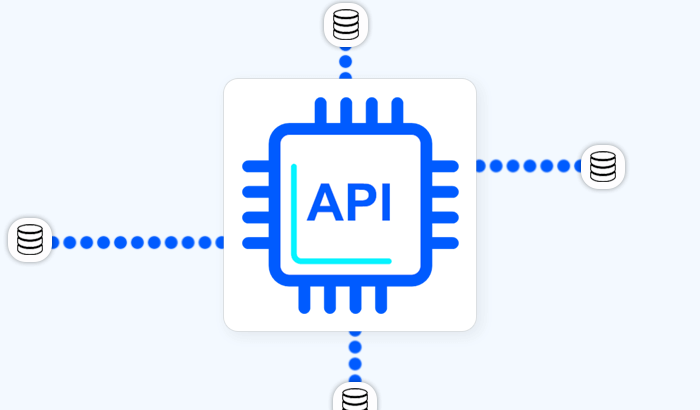- What is lead generation scraping?
- Why is lead generation important for brands?
- Benefits of lead scraping for business
- What kind of data can you get from web scraping?
- How do you generate leads with web scraping?
- How to use the scraped data
- Challenges in lead scraping
- Methods to scrape leads
- How to choose a website to scrape prospects
- How to use Infatica’s web scraping API for lead generation?


Lead generation has become a crucial component for businesses aiming to expand their customer base and drive growth. Leveraging web scraping techniques for high-quality leads offers an efficient and scalable way to gather valuable data on potential prospects – and this article explores the essential elements of lead generation scraping.
We’ll discuss the benefits and challenges of various scraping methods and provide insights on choosing the right websites to scrape. Additionally, we’ll delve into practical applications of scraped lead data across different communication channels and highlight the functionalities of Infatica’s Web Scraper API as a powerful tool for automating this process. By the end of this article, you’ll have a comprehensive understanding of how to harness scraping for lead generation and the strategic advantages it can offer your business.
What is lead generation scraping?
Web scraping for lead generation involves several steps, with the end goal being to extract web data. Here’s how such a pipeline typically works:
1. Identify sources: We start by finding websites that contain the desired contact information. This can include social media platforms, business directories, industry-specific sites, blogs, and forums. Additionally, we can look for publicly available web scraping APIs that can provide structured data directly.
2. Set up web scraping tools: Web scraping libraries, frameworks, and suites such as BeautifulSoup, Scrapy, Selenium, Puppeteer, or Infatica Scraper API are the most important software, alongside headless browsers like Chrome or Firefox to handle websites that require JavaScript rendering.

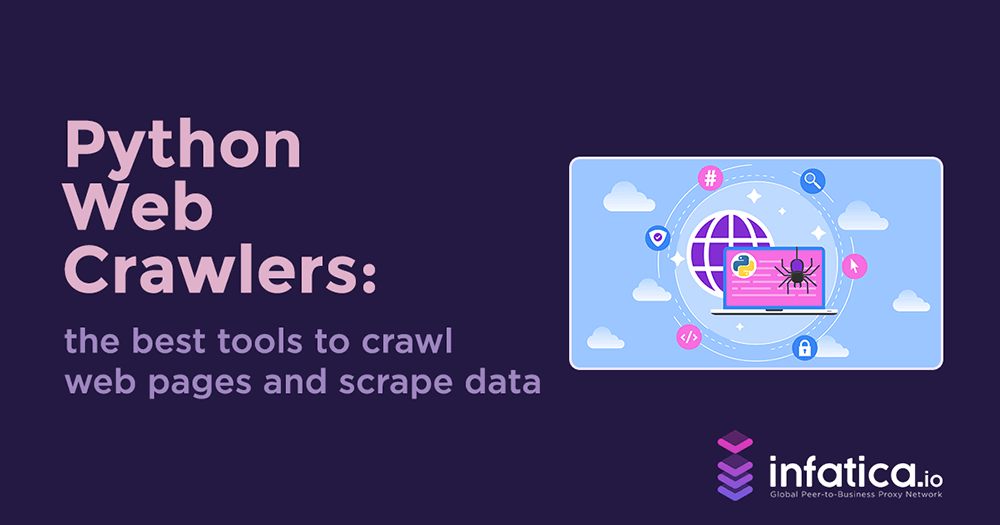
3. Configure the scraper: Next, we write scripts to send HTTP requests to the target websites and fetch the HTML content – and use parsing libraries (e.g., BeautifulSoup) to extract web data from the HTML structure. Pagination can also cause some problems, so ensure your scraper can navigate through paginated content to collect all available data.
4. Clean and process data: We need to remove duplicates, handle missing values, and correct inconsistencies in the data – then, we can convert the data into a structured format like CSV, JSON, or directly into a lead database.
5. Store and manage data: We’ll also need to store the cleaned and structured data in a database (e.g., MySQL, PostgreSQL, MongoDB) for easy access and management. For large-scale operations, you can consider using data warehouses (e.g., Amazon Redshift, Google BigQuery) for efficient querying and analytics.
6. Lead scoring and segmentation: Additionally, we can implement algorithms to score leads based on relevance and potential value. Factors may include company size, industry, job title, and engagement level. For better segmentation, we can categorize leads into different segments based on criteria such as geographical location, industry, or behavior.
7. Utilize leads: Finally, we can Import the leads into a CRM system (e.g., Salesforce, HubSpot) for the production and sales process to follow up. We can use the leads for targeted email marketing campaigns, social media outreach, and other marketing strategies.
Why is lead generation important for brands?
It drives growth by identifying and cultivating prospective customers who have shown interest in their products or services – and build relationships later. By generating leads, brands can build a pipeline of prospective clients, ensuring a steady flow of new business opportunities. This process helps to understand the target audience, enhancing marketing efficiency, and ultimately increasing conversion rates. Effective lead generation also allows brands to gather data on potential customers and track their behavior over time, which can be used to tailor marketing strategies and create personalized experiences that resonate with the target audience.
Moreover, lead generation is essential for maintaining a competitive edge. In a crowded market, consistently acquiring and nurturing new leads helps brands stay relevant and expand their target customer base. It supports the sales team by providing qualified leads, thereby improving sales performance and revenue. Additionally, lead generation fosters long-term relationships with customers by initiating engagement early in the buying journey, which can lead to higher customer retention and brand loyalty. Overall, it is a foundational component of a brand’s growth strategy, driving both immediate sales and sustainable business development.
Benefits of lead scraping for business
Web scraping for lead generation can offer multiple benefits: It can save time, generate qualified leads, build relationships, and more. Let’s take a closer look at three major upsides:
Efficiency and resource optimization
We can automate data collection of potential customer information from various online sources – and significantly save time and money required compared to manual methods. This automation allows businesses to allocate resources more effectively, focusing their lead generation efforts on high-value tasks such as strategy development, personalized marketing, and customer engagement. With higher data accuracy, lead scraping ensures a steady flow of relevant leads, maximizing productivity and optimizing the overall efficiency of the sales and marketing teams.
Gaining customer insights
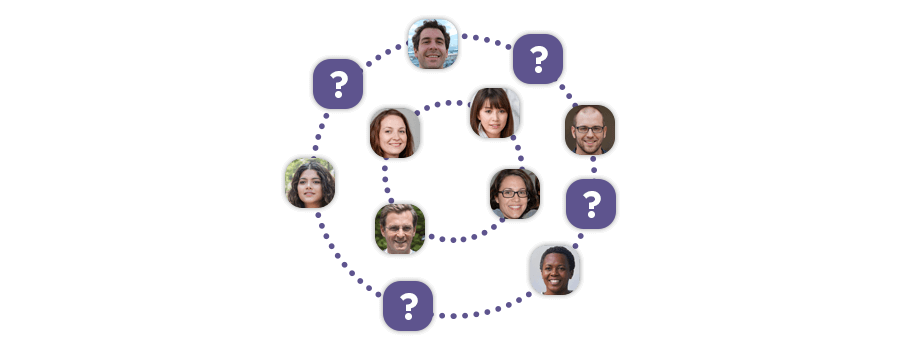
Lead scraping provides businesses with a wealth of data about potential customers, including their interests, customer behavior trends, and demographics. Analyzing this data allows companies to gain deep insights into customer preferences and trends, enabling them to tailor their products, services, and marketing strategies to better meet the needs of their target audience. These valuable insights facilitate more informed marketing decisions and help in creating personalized customer experiences that can enhance satisfaction and loyalty.
Staying ahead of the competition
In a competitive market, having access to up-to-date and comprehensive lead data gives businesses a significant advantage: Companies can quickly identify opportunities, keeping their sales pipelines full and their market strategies agile. By continuously monitoring and gathering data from competitors’ activities and industry trends, businesses can stay ahead of the market competition, adapt to market changes swiftly, and maintain a competitive edge. This proactive approach to lead generation helps in securing a stronger market position and driving sustained growth.
What kind of data can you get from web scraping?
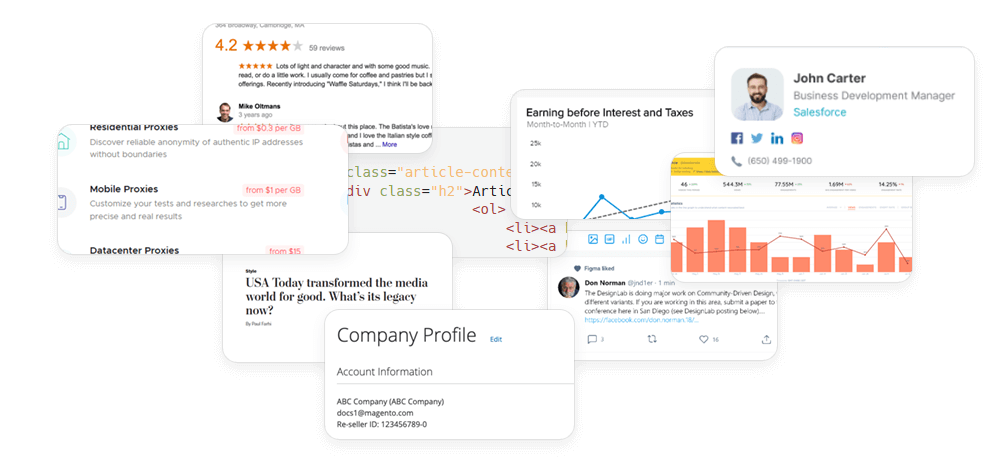
Web scraping can extract a wide variety of data types from websites, depending on the specific needs and goals of the user. Here are some common types of data that can be obtained through data scraping:
- Сontact data: full names of individuals or business entities, publicly listed email addresses, and contact phone numbers.
- Company information: names of businesses or organizations, physical locations and mailing addresses, URLs of company websites, and information on the industry sector the company operates in.
- Product and service information: names of products or services offered, detailed descriptions of products or services, pricing information, including discounts and offers, and availability and stock levels of products.
- Social media data: information from social media profiles, content from social media posts and updates, data on followers, likes, and connections.
- Customer reviews and ratings: text of customer reviews, numerical ratings or stars given by customers, and overall sentiment or tone of the reviews.
- Event information: names and titles of events, event schedules and venues, and information on speakers and notable attendees.
- News and articles: titles of news articles or blog posts, full text or summaries of articles, and dates when the articles were published.
- Financial data: current and historical stock prices, key financial metrics and reports, and data on investments and funding rounds.
- Metadata: tags and keywords associated with web pages, addresses of the web pages where data is extracted, and dates and times when the data was scraped.
How do you generate leads with web scraping?
Lead generation strategies have various nuances – this mainly depends on the given industry. Let’s explore these five scenarios:
Lead generation in B2B
In B2B, the focus is on identifying and engaging with a small number of customers (compared to the B2C sector) that may be interested in your products or services. This often involves scraping professional networking sites like LinkedIn to gather information about companies, key decision-makers, and their contact details. Additionally, extracting data from industry-specific online directories, business association websites, and conference attendee lists can help in compiling a list of potential leads for higher revenues. These leads can then be segmented based on criteria such as industry, company size, and geographical location to tailor marketing efforts effectively. Personalized outreach, such as targeted emails and direct messages, can further engage various customers representing businesses and convert them into clients.
Lead generation in real estate

In real estate, web scraping for lead generation helps to identify potential buyers/sellers. Web scraping can be used to extract data from property listing websites, real estate forums, and social media groups where users discuss real estate transactions. Information such as contact details, budget range, property preferences, and location preferences can be gathered and organized. Additionally, scraping public records and local government databases can provide data on property ownership and recent transactions. Real estate agents can then use this information to reach out to potential buyers or sellers with tailored property suggestions and market insights.
Lead generation in e-Commerce
For e-commerce businesses, market research for lead generation involves attracting potential customers who are likely to purchase products from the online store. This can be achieved by scraping social media platforms and forums to analyze reviews and identify dissatisfied customers. Gathering data from competitors’ websites, such as customer reviews and ratings, can also provide insights into competitor customers. Additionally, offering incentives like discounts or free trials in exchange for email sign-ups can help build a mailing list of interested prospects. This list can be used to send personalized marketing campaigns, product recommendations, and promotional offers to drive conversions.
Google Maps
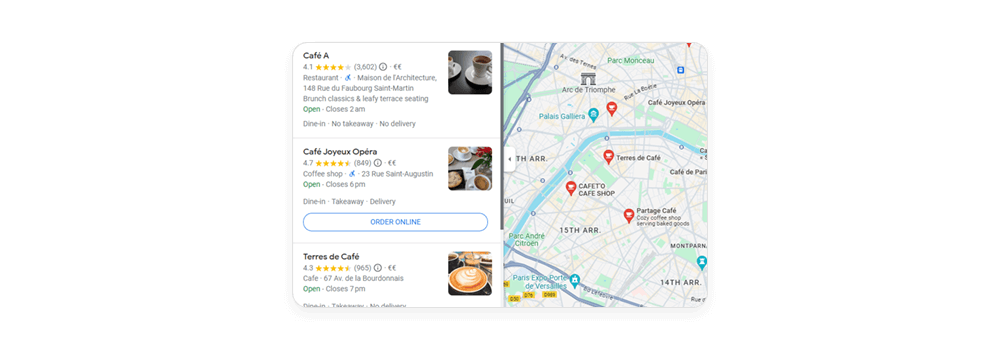
Google Maps is a valuable lead generation tool, especially for businesses looking for local insights. By scraping data from Google Maps, you can collect POI data about businesses within a specific geographical area, including their contact details, business hours, customer reviews, and ratings. This data can help in creating a targeted list of local businesses that might be interested in your products or services. For instance, a supplier might use this information to reach out to local restaurants, retailers, or service providers. Personalized marketing campaigns and local SEO strategies can then be employed to engage these leads effectively.
Yelp & Yellow Pages
Yelp and Yellow Pages are rich sources of business data, particularly for small and local businesses. Scraping these directories allows you to collect comprehensive business profiles, extracting contact information, business categories, customer reviews, and ratings. This data can be used to identify businesses that fit your target market criteria. For example, a digital marketing agency could scrape data from Yelp for competitive analysis: for example, to find local businesses with low ratings and offer their services to improve their online presence.
How to use the scraped data
Collecting data is just half the task – how can we make it more actionable and use it later to generate business leads? Some methods can include cold outreach, emails, messenger, phone calls, and more:
Emails
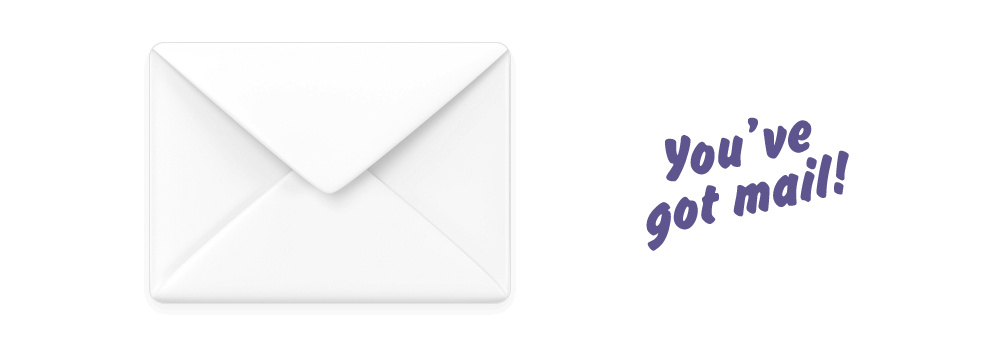
Using scraped lead data for email outreach is a popular method: It involves crafting personalized emails campaigns based on the information collected. With detailed contact information and insights into the leads' preferences and behaviors, you can create tailored email content with a clear call to action that addresses their specific needs and interests. This could include introducing your products or services, offering special promotions, or providing valuable industry insights. Segmenting your email list based on criteria such as industry, job role, or past interactions can further enhance the relevance and effectiveness of your emails, increasing open rates and engagement.
Messenger outreach

In some scenarios, messenger outreach is an even more effective method: It leverages instant messaging platforms like Facebook Messenger, WhatsApp, or LinkedIn messages to directly connect with leads. Using the scraped data, you can perform tailored messaging that initiate conversations, address specific needs, or offer solutions. This method allows for real-time communication, enabling immediate responses to questions and concerns. Crafting thoughtful, targeted content based on the lead’s profile information can foster a more personal connection and increase the likelihood of a positive response and engagement.
Phone calls
Thanks to personalized conversations, phone calls allow for a more direct and personal approach to engaging potential clients. With detailed information about the lead, such as their name, company, and specific needs or pain points, sales representatives can understand needs of their leads and make informed and relevant pitches. Personalizing the conversation based on the lead’s background and demonstrating a clear understanding of their challenges can significantly increase the chances of a successful call. Phone calls are particularly effective for building rapport and trust, answering complex questions, and closing deals.
Social media
Scraped lead data can be used to connect with the target audience on social media platforms like LinkedIn, Twitter, or Instagram. By understanding the interests and activities of your leads, you can interact with them, share content, and join conversations they are part of. This strategy helps build brand awareness and establish credibility. Additionally, you can use targeted advertising to reach leads with personalized content that resonates with their preferences and needs, driving traffic to your website or landing pages and encouraging further engagement.
Direct mail
Direct mail involves sending physical promotional materials, such as brochures, flyers, or personalized letters, to the leads' postal addresses obtained through scraping. Using the data to tailor the content of the print materials ensures that it is relevant and appealing to the recipient. Direct mail can stand out due to its tangible nature, often leading to higher engagement rates compared to digital methods. Personalized messages, special offers, and calls to action within the direct mail can effectively capture the attention of potential clients and encourage them to take the next step, whether it’s visiting your website, making a call, or attending an event.
Challenges in Lead Scraping
However, lead scraping isn’t without its challenges:
IP blocking
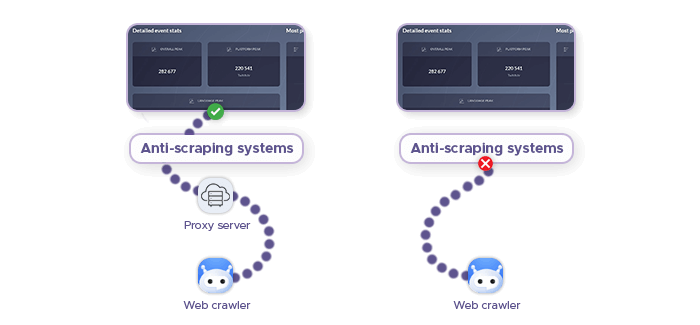
IP blocking is a significant challenge in the process of scraping leads: Many websites employ measures to detect and block multiple requests coming from the same IP address to prevent automated scraping activities. When bots send too many requests in a short period, the website may temporarily or permanently block their IP addresses, often stopping the entire data pipeline. To overcome this, scrapers can use techniques like rotating IP addresses through proxies, implementing time delays between requests, and mimicking human browsing behavior to avoid detection and maintain access to the target site.
Complex Website Structure
A complex website structure can pose a challenge for lead scraping as they may include dynamic content, nested elements, and non-standard HTML. Websites built with JavaScript frameworks often require additional processing to render the content fully before it can be scraped. For example, for a LinkedIn scraper, navigating through multi-level menus, handling AJAX calls, and extracting quality data from deeply nested elements can complicate the lead generation process. To address this, scrapers can use tools like Selenium or Puppeteer, which can interact with and render JavaScript-heavy websites or write custom parsing logic to handle complex HTML structures effectively.
Website Design
Frequent changes in website design and layout can disrupt scraping operations, as the scraper's logic is typically tailored to the specific structure of the target site. When a website updates its design, changes in element identifiers, HTML tags, or the overall structure can cause the scraper to break or collect incorrect data. Maintaining a scraper in such an environment requires continuous monitoring and updates to the scraping logic to adapt to these changes. Employing robust error-handling mechanisms and developing modular, flexible scraping scripts can help mitigate the impact of design changes.
Methods to scrape Leads
There are several lead scraping methods, programming-wise. Let’s explore their pros and cons:
No-code Web Scraping
| Pros | Ease of use: No-code lead generation tools are designed for users without programming skills, offering intuitive interfaces (e.g. Airtable) and drag-and-drop functionality (e.g. scheduling). | Speed: Setup is typically quick, allowing users to start scraping data almost immediately. | Maintenance: Updates to the APIs and maintenance are handled by the service provider, reducing the need for ongoing technical adjustments. |
| Cons | Flexibility: These tools might be limited in terms of customization and handling complex scraping tasks or dynamic websites. |
Scalability: No-code web scraping may struggle with large-scale scraping projects or frequent, high-volume data extraction needs.
|
Cost: Although convenient, no-code tools often come with subscription fees that can add up over time, especially for extensive use.
|
Creating your own Scrapers
| Pros |
Customization: Building your own lead scraper allows for complete customization to meet specific data extraction needs and handle complex website structures.
|
Scalability: Custom scrapers can be optimized for performance and scaled to handle large volumes of data efficiently.
|
Cost-effectiveness: While there is an initial investment in development, creating your own scrapers can be more cost-effective in the long run, especially for extensive or ongoing scraping projects.
|
| Cons |
Technical expertise: Developing and maintaining custom scrapers requires significant programming knowledge and expertise, typically in Python or Node.js.
|
Maintenance: Web scraping code must be continuously updated to adapt to changes in website structures, which can be time-consuming and resource-intensive.
|
Initial setup time: Creating and testing custom scrapers can take a considerable amount of time before they are fully operational.
|
Web Scraping API
| Pros |
Simplicity: Infatica’s Web Scraper API abstracts much of the complexity involved in web scraping (e.g. managing headers and browsers) providing a straightforward way to extract data without dealing with the intricacies of web page structures.
|
Reliability: Thanks to robust proxies, managed web scraping services offer reliable performance and built-in handling of issues like IP blocking and CAPTCHA solving. |
Scalability: The web scraping API is designed to handle large-scale scraping tasks efficiently, making it suitable for extensive data collection needs.
|
| Cons |
Cost: Using a managed API service like Infatica can be on the more expensive side, especially for high-volume scraping.
|
Less control: While the API simplifies scraping, it may offer less control over the specifics of how data is extracted compared to custom-built scrapers.
|
How to choose a website to scrape prospects
Choosing a website to scrape for prospects involves evaluating several key criteria to ensure the site meets your needs and is appropriate for your lead generation efforts. Here’s a detailed look at the criteria to consider:
1. Relevance: Ensure the website’s user base or listed entities align with your target market. For instance, if you are looking for B2B leads, professional networking sites or industry-specific directories would be more relevant than general social media platforms. Also, choose websites that cater specifically to the industry or niche you are targeting. Relevant websites will provide more quality leads.
2. Data quality: Assess the credibility and reputation of the website – scraping data from reputable and well-established sites ensures the information is reliable and up-to-date. High-quality websites usually have better-organized and more accurate data, reducing the need for extensive cleaning and validation post-scraping.
3. Legal considerations: Review the website’s terms of service and privacy policy to understand the legality of web scraping on that platform. Some websites explicitly prohibit scraping in their terms.
4. Data availability: Evaluate how easily accessible the required data is on the website. Sites that present data in a structured format, like tables or listings, are easier to scrape. Also, remember about anti-scraping mechanisms such as CAPTCHAs, IP blocking, or JavaScript-rendered content. Websites with fewer barriers are more straightforward to scrape.
5. Data structure: Examine the website’s HTML/CSS structure to determine if the data is organized logically and consistently across pages. Well-structured sites with clear identifiers (e.g., classes, IDs) are easier to parse.
How to use Infatica’s web scraping API for lead generation?
Using Infatica’s Web Scraper API for lead generation involves a series of steps to ensure you can efficiently and effectively extract the required data:
1. Sign up: Start by registering on Infatica’s website. Once registered, you will receive an API key. This key is essential for authenticating your requests to the API.
2. Make an API request: Use the API key to construct your HTTP request, specifying the target URL you want to scrape and any additional parameters required by Infatica’s API. Include the API key in your request headers for authentication.
3. Handle the response: Once you receive a response, parse the JSON data to extract the relevant information for your lead generation efforts. Implement error handling to manage potential issues such as rate limits, API errors, or changes in website structure.
4. Store and analyze data: Store the scraped data in a database or a structured format like CSV for further data analysis. Clean and preprocess the data to ensure it is accurate and formatted correctly.
5. Utilize data for lead generation: Use the extracted data to enrich your lead profiles, adding valuable information such as contact details, company information, or social media profiles. Segment the business leads based on relevant criteria such as industry, job role, or location to tailor your outreach efforts – and integrate the enriched lead data into your CRM system and launch targeted marketing and sales campaigns.
Conclusion
Web scraping stands out as a pivotal technique for modern lead generation, enabling businesses to efficiently collect and utilize data from a variety of online sources. We’ve examined the specific benefits of web scraping, such as efficiency, gaining customer insights, and maintaining a competitive edge. By integrating tools like Infatica’s Web Scraper API, businesses can streamline their lead generation efforts, ensuring they have access to high-quality, actionable data.





